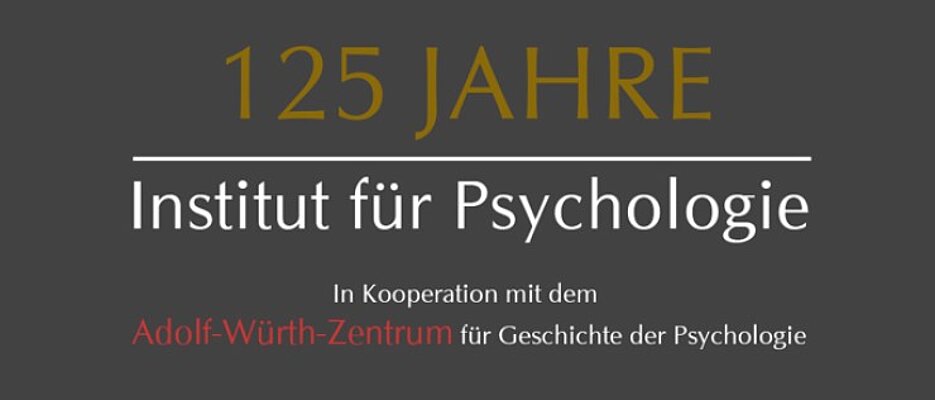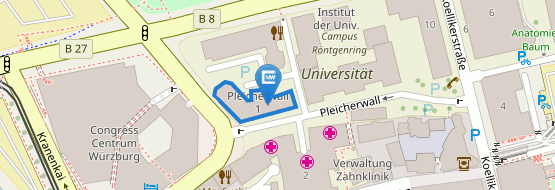On the track of thought
12/09/2021The Institute of Psychology at the University of Würzburg was established 125 years ago. Shortly after its foundation in 1896, it resulted in a world-renowned school: the Würzburg School of Thought.
Sometime in 1900: Concentrated, Oswald Külpe (1862-1915), holder of the Würzburg professorship for philosophy including aesthetics, is sitting as a test subject on the second floor above the library in the Old University. Külpe had been given the rooms, initially on a revocable basis, for research purposes and for his teaching in psychology since the winter semester of 1896, after their previous occupants had moved to the new building on Sanderring.
His closest and only collaborator, Karl Marbe (1869-1953), is the experimental director. Together they work with the newly conceived method of controlled systematic introspection to elicit the secrets of thought. The duo quickly grows to include interested students and foreign guest scientists. A whole series of research papers emerge, reporting new discoveries about thinking in its many facets. Soon they are sure that some common doctrines and especially the then widespread association psychology is inadequate, at least in parts.
Thinking - according to Külpe and Marbe - is sometimes vivid, but much more often vague, a process that is often difficult to describe verbally, and to which the term "states of consciousness" was given. But these may well be accompanied by feelings of tension, even excitement, to be finally discharged by a sudden insight into a context, a realization or a solution to a problem, in a liberating "aha experience".
The Aha-experience - a discovery of the Würzburg Psychology of Thought
Yes, indeed, the "aha-experience" was discovered in Würzburg - namely by Karl Bühler (1879-1963), a well-known fellow member of the Würzburg School, who published this phenomenon known to everyone in 1908 as part of his habilitation thesis. Just like "X-rays", the term began a triumphal march around the world, and just as with Röntgen, most people do not know that the University of Würzburg was the birthplace.
As is all too often the case, the new findings soon found themselves in fierce and public conflict with the traditional ones. No less a figure than the forefather of psychology, Wilhelm Wundt (1832-1920), fiercely attacked the students of his former and long-time assistant Oswald Külpe. Wundt probably did not consider that he was making the Würzburg School really famous by initiating this conflict.
These scientific successes made Oswald Külpe, who had been working at the Alma Julia since 1894, a sought-after candidate for appointment. As early as 1903, Stanford University in California tried to poach him, and in 1904 the University of Münster followed with a call. Both could be fended off and Külpe was persuaded to stay. In 1909, the courtship of the University of Bonn became too intense, and Külpe left Würzburg to found further psychological institutes in Bonn and subsequently also at the University of Munich.
The Institute in a quarter of a century under Karl Marbe
For the professorship thus vacated, the faculty wished to have Karl Marbe return to Würzburg, who had in the meantime been appointed to the College of Trade and Social Sciences, the predecessor of the University of Frankfurt, founded in 1914. The call succeeded, and Marbe served as full professor of psychology from 1909 to 1935. He certainly led the institute through the end of the imperial era, the First World War, through the economic crises of the Weimar Republic, and into the Third Reich.
Although he had not yet reached the age limit of 68, a new "Law on the Dismissal and Transfer of University Teachers on the Occasion of the Reconstruction of the German University System" of January 21, 1935, was his undoing. This allowed professors who had become disagreeable to be removed from office prematurely. Marbe had become disliked not only because his wife was of Jewish origin and he refused to divorce, but also because he had the audacity to conduct the doctoral examination from the Jew and later Rabbi Leo Trepp as late as 1935.
Psychological explanation of the Nazi seduction mechanisms
The research achievements of the institute headed by Marbe were considerable and extraordinarily diverse. In addition to numerous works on applied psychology, the psychotechnology of the time, his large, two-volume work on uniformity in the world (1916, 1919) stands out, from which he secretly derived a small paper on the psychological explanation of the seduction mechanisms of the National Socialists between 1943 and 1945. If a malicious denunciation had led to their discovery, it would probably have been over for the Marbe couple.
The couple steadfastly endured the hostility of the Nazi era, helped by the fact that Marbe had earned a high reputation in legal circles as one of the first psychological legal experts. In the face of death, the Marbe couple also survived the devastating night of bombing on March 16, 1945, which almost wiped out Würzburg.
The rather inconspicuous Carl Jesinghaus during the Nazi era
Marbe was succeeded in 1935 by Carl Jesinghaus (1886-1948), who was appointed by the NSDAP Reichsleitung in Berlin against any votes of the faculty. He had held a professorship in Argentina before returning to Germany, was an experimental psychologist trained at the Wundt Institute in Leipzig, and thus preferred even Marbe to having a philosopher again hold the professorship won for psychology.
Jesinghaus was not very conspicuous, published hardly at all, and when he did, it was in Spanish. In 1938, he succeeded in moving the institute from the Alte Universität to Klinik Straße 8, thus expanding and modernizing it. He was also able to prevent the closure of many institutes, often ordered with the beginning of the war, for psychology, and thus research and teaching continued under the increasingly difficult conditions of the war. Late in the evening of March 16, 1945, this came to an end. The institute burned to the ground in a hail of phosphorus.
Like a phoenix from the ashes
As early as the spring of 1946, a search was underway to find a new occupant for the Institute of Psychology. The Dresden psychologist Gustav Kafka (1883-1953) was under discussion. Kafka had resigned from the German Psychological Society in protest in 1933, when the society was rushing to expel Jewish members. With the help of a doctor friend, he is said to have succeeded in feigning a serious illness so convincingly that he was retired at a young age while still receiving his salary. Kafka thus evaded the Nazi regime and awaited its end, which he was lucky enough to live to see, despite burn injuries during the nights of bombing in Dresden.
When he arrived in Würzburg, he is said to have owned only a pair of trousers. Students sewed an old pair of military trousers around him and gave them to him anonymously, knowing full well that he would otherwise have been too reserved and modest to accept them.
In a basement room at Sanderring 2, the Institute of Psychology rose again under Kafka, and not only that: Kafka also succeeded in reestablishing the German Society of Psychology in the American sector. He became its president from 1951 until shortly before his death in 1953. Through Gustav Kafka, the Institute of Psychology regained its reputation.
Wilhelm Arnold laid the foundation for a long-lasting expansion phase
Kafka was to be followed by Wilhelm Arnold (1911-1983). Arnold worked full-time as a psychologist in a senior position at the Institute for Employment Services in Nuremberg before accepting the call to Würzburg. Here, too, politics played a major role, since Arnold was not the faculty's preferred candidate, but a founding member of the CSU in northern Bavaria. However, the university, thus duped, did not resent the ministry for long, for Arnold continued to build and expand the Institute of Psychology very successfully.
As early as 1956, a new domicile for psychology was inaugurated at Domerschulstraße 13. At that time, it was one of the best-equipped institutes for psychology, not least because Arnold had succeeded in landing lucrative research contracts through his contacts in industry. The institute even had a branch office in Sezze, located between Rome and Naples. Here, under the direction of Dr. Hermann Forster, comparative linguistic and international psychological research was conducted. This had a thoroughly pragmatic contemporary historical background, as Prof. Arnold was interested in the development of selection procedures for Italian guest workers.
Arnold's manner was that of a shrewd science politician rather than a profound basic researcher immersed in himself. Consistently, he became the first psychologist to serve as rector of Alma Julia from 1964 to 1966. He took advantage of these opportunities and initiated the expansion phase of psychology that continues to this day with the establishment of a second professorship.
Numerous new chairs
As early as 1966, Ludwig Pongratz (1915-1995) was appointed to Chair II and from then on represented clinical psychology, among other fields. In 1975, the Chair III for General Psychology and Methodology was established under the direction of Otto Heller (1925-2012). Finally, in 1977, the Chair of Educational Psychology, held by Heinz Alfred Müller (1930-1990), was integrated into the Institute of Psychology as Chair IV after the dissolution of the Würzburg University of Education.
Over the years, further professorships were added to the chairs, and the revolving carousel of appointments had Wilhelm Arnold followed by Wilhelm Janke (1933-2011), Heinz Alfred Müller by Wolfgang Schneider, Otto Heller by Joachim Hoffmann, Ludwig Pongratz by Barbara Zoeke, and finally Fritz Strack. All of these are now retired, and a new generation of psychologists has followed them. The Institute has succeeded in attracting outstanding researchers to this day, and has thus remained an internationally highly renowned, innovative, and research-strong institute almost continuously since the Külpe era.
A pandemic online celebration
Reason enough to celebrate the now 125-year history in an online ceremony together with many former and current employees of the Institute of Psychology. Speakers at the ceremony included the President of the University of Würzburg, Paul Pauli, who also has a background in psychology, the current President of the German Psychological Society, Professor Markus Bühner, who once studied psychology in Würzburg, the Dean of the Faculty of Human Sciences, Professor Johannes Hewig, who also belongs to the Institute of Psychology, and the Executive Director of the Institute of Psychology, Professor Wilfried Kunde.
During the ceremony, the online exhibition "Facets from the 125-year history of the Institute of Psychology", prepared by the Adolf Würth Center for the History of Psychology under the direction of Professor Armin Stock, was also opened. It can now be visited under the following link:
Facetts in the History of the Institute of Psychology



![[Translate to Englisch:] Oswald Külpe vor einem Doppelschallpendel](/fileadmin/_processed_/8/4/csm_Oswald_Kuelpe_f7b191118c.jpg)
